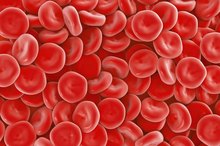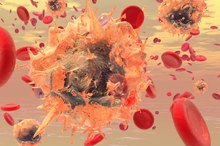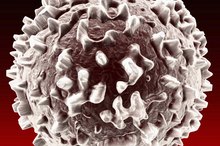The Effects of Low White Blood Cells on Healing After Surgery
Normally, one drop of blood contains between 7,000 and 25,000 white blood cells, according to the Franklin Institute (see link in Resources Section below). And these cells, the body’s defense system against infections and germs, only live a few days or weeks. Therefore, it is important–especially after surgery and during recovery–to have an ample supply of white blood cells in order to immediately address any germs or infections that may appear on the scene. While the goal is to have a good supply, you can have too many (as in the case of leukemia) or too few, which is just as bad.
If you are experiencing serious medical symptoms, seek emergency treatment immediately.
White Blood Cells (Leukocytes) Defined
The heart, veins, capillaries and arteries all contain white blood cells (leukocytes), as well as red (erythrocytes) blood cells. Several types of white blood cells exist (neutrophils, eosinophils, lymphocytes, monocytes and granulocytes), and approximately 95 percent of all of them are produced in the bodies bone marrow. White blood cells are responsible for protecting us against allergens, germs and infections. They aid in the healing process and help to protect us against cell mutations that lead to cancer.
- The heart, veins, capillaries and arteries all contain white blood cells (leukocytes), as well as red (erythrocytes) blood cells.
- Several types of white blood cells exist (neutrophils, eosinophils, lymphocytes, monocytes and granulocytes), and approximately 95 percent of all of them are produced in the bodies bone marrow.
Effect of Low White Blood Cells: A Compromised Immune System
Causes of Low Platelet Count & Abnormal White Blood Cells
Learn More
When we have too few white blood cells in our body (below the minimum 7,000 cells normally found in one drop of blood), then we are at risk for succumbing easier to any allergen or germ that attempts to enter our blood stream. Thus one effect of having a low white blood cell count is a compromised immune system.
Compromised Immune System Effects
A compromised immune system can, in turn, have many negative effects on the body: it will make the body more susceptible to infections, diseases and conditions like hepatitis, pneumonia, bleeding disorders and anemia. It will reduce the body’s ability to heal wounds, especially important for those who have been injured. However, it can also impact those recovering from surgery wounds too. And, due to the compromised system, the white blood cells will not be able to aid in preventing cell mutations.
- A compromised immune system can, in turn, have many negative effects on the body: it will make the body more susceptible to infections, diseases and conditions like hepatitis, pneumonia, bleeding disorders and anemia.
Low White Blood Cell Effects on Surgery Healing
Diseases That Cause Low Red Blood Count
Learn More
In addition to being responsible for battling allergens, germs and infections, our white blood cells are also responsible for helping our bodies to heal. They do this through ingesting materials that need to removed from the body. Three of these materials are: old red blood cells, debris from body tissues and dead cells in the body. However, if the white blood cells in the body are low, they will be more likely to be unable to remove material from the body that could be toxic if left to remain, promoting the possibility of complications for the patient who is trying to heal.
- In addition to being responsible for battling allergens, germs and infections, our white blood cells are also responsible for helping our bodies to heal.
- However, if the white blood cells in the body are low, they will be more likely to be unable to remove material from the body that could be toxic if left to remain, promoting the possibility of complications for the patient who is trying to heal.
Significant
In addition to the effects to the immune system, the body's ability to heal from wounds and surgery, and the inability to remove waste, having low white blood cells also increases the risk of cell mutation. Cell mutation is generally kept in check by properly functioning white blood cells. However, if that cell count is too low, the white blood cells--already spread thin on their main assignment (immune system activities)--will be unable to fight abnormal cell multiplication and, thus, increase the risk for cancerous and noncancerous cell proliferation.
- In addition to the effects to the immune system, the body's ability to heal from wounds and surgery, and the inability to remove waste, having low white blood cells also increases the risk of cell mutation.
- However, if that cell count is too low, the white blood cells--already spread thin on their main assignment (immune system activities)--will be unable to fight abnormal cell multiplication and, thus, increase the risk for cancerous and noncancerous cell proliferation.
Related Articles
References
- Mayadas TN, Cullere X, Lowell CA. The multifaceted functions of neutrophils. Annu Rev Pathol. 2014;9:181-218. doi:10.1146/annurev-pathol-020712-164023
- Mcbrien CN, Menzies-gow A. The Biology of Eosinophils and Their Role in Asthma. Front Med (Lausanne). 2017;4:93. doi:10.3389/fmed.2017.00093
- Cromheecke JL, Nguyen KT, Huston DP. Emerging role of human basophil biology in health and disease. Curr Allergy Asthma Rep. 2014;14(1):408. doi:10.1007/s11882-013-0408-2
- Hoffman W, Lakkis FG, Chalasani G. B Cells, Antibodies, and More. Clin J Am Soc Nephrol. 2016;11(1):137-54. doi:10.2215/CJN.09430915
- Karlmark KR, Tacke F, Dunay IR. Monocytes in health and disease - Minireview. Eur J Microbiol Immunol (Bp). 2012;2(2):97-102. doi:10.1556/EuJMI.2.2012.2.1
- Görgens A, Radtke S, Horn PA, Giebel B. New relationships of human hematopoietic lineages facilitate detection of multipotent hematopoietic stem and progenitor cells. Cell Cycle. 2013;12(22):3478-82. doi:10.4161/cc.26900
- Hong JW, Noh JH, Kim DJ. Association between White Blood Cell Counts within Normal Range and Hemoglobin A1c in a Korean Population. Endocrinol Metab (Seoul). 2018;33(1):79-87. doi:10.3803/EnM.2018.33.1.79
- Riley LK, Rupert J. Evaluation of Patients with Leukocytosis. Am Fam Physician. 2015;92(11):1004-11.
- Flores-mireles AL, Walker JN, Caparon M, Hultgren SJ. Urinary tract infections: epidemiology, mechanisms of infection and treatment options. Nat Rev Microbiol. 2015;13(5):269-84. doi:10.1038/nrmicro3432
- Kasi PM, Grothey A. Chemotherapy-Induced Neutropenia as a Prognostic and Predictive Marker of Outcomes in Solid-Tumor Patients. Drugs. 2018;78(7):737-745. doi:10.1007/s40265-018-0909-3
- U.S. Library of Medicine. MedlinePlus. White Blood Cell Count. https://medlineplus.gov/ency/article/003643.htm
Writer Bio
Holly Huntington's writing has been published online by eHow.








